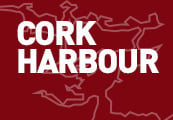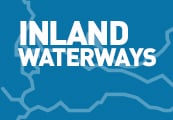Displaying items by tag: Sail Training
Tall Ship ‘Lord Nelson’ Put Up for Sale by Online Action
Lord Nelson, the former flagship tall ship of the Jubilee Sailing Trust, has been put up for sale by online auction.
Global advisory and investment firm Gordon Brothers was last October appointed as exclusive selling agent for the tall ship on behalf of the Jubilee Sailing Trust Limited after the troubled charity was placed into administration.
It’s now offering the vessel for sale by online auction with bids opening at £150,000 and accepted until Friday 30 June.
Built in 1985, Lord Nelson is the first tall ship in the world designed to accommodate personnel of all physical abilities to sail alongside the ship’s crew.
The 55-metre, 368-tonne sail training barque — which was decommissioned in 2019 — includes accessible toilets, a speaking compass, braille and power-assisted bridge.
Announcing the auction on Wednesday (7 June), Simon Bamford, director of commercial and industrial at Gordon Brothers said: “Lord Nelson is back on the market and presents a fantastic and rare opportunity to acquire a vessel through an online auction within the international marine markets.
“This historic and renowned training ship accommodates any individual who sails and has circumnavigated the globe and sailed at various races and regattas.”
Dublin Under Sail has appointed Liam Quinn as Operations Manager and Skipper of the Sail Training Ketch Brian Ború.
Liam started out his maritime career many years ago on fishing boats and, as a young man, learned to sail on Mirror dinghies.
When Asgard II was launched in his native Arklow, he immediately joined as a trainee on one of the first voyages and went on to be a watch leader on Ireland’s beloved sail training vessel, learning from one of the legends of Irish sailing Eric Healy. He continued his sailing career with Jubilee Sailing Trust’s tall ships, Lord Nelson and Tenacious.
In recent years, he has been skipper of the ketch RV Celtic Mist with the Irish Whale and Dolphin Group, including skippering the trip from Ireland to Iceland in 2018 and research trips to the continental shelf on the Live on the Edge survey voyages. He is a regular racing crew, including on the gaff ketch Maybird in the Round Ireland Race, Dun Laoghaire to Dingle Race and Irish Sea races.
Liam has been on board Brian Ború for some recent voyages and says he is “looking forward to getting back into sail training and skippering Brian Ború on voyages this coming season on the Irish coast and to Scotland and the Isle of Man.”
Liam will work with Engineer Hugh Byrne, Skipper/Instructor Peter Scallan and the entire crew panel to keep Brian Ború shipshape for both day trips and sail training voyages.
Brian Ború will be busy on sail training voyages from June to September as well as participating in Coastival, the Dun Laoghaire Maritime Festival, from 1 to 9 July.
Drogheda Sail Training Bursary Celebrates 10th Anniversary
In 2013, the Drogheda Sail Training Bursary was established as the country’s first scheme of its kind, funding the development of local young people through the medium of Sail Training. This anchor scheme has led to the subsequent development of similar bursary schemes across Ireland and Northern Ireland. The Drogheda Bursary Scheme relies entirely on the commitment and integrity of a small group of corporate sponsors who are very strong advocates of corporate social responsibility, youth development and community spirit.
Drogheda Port Company hosted an event for sponsors and supporters of the Drogheda Sail Training Bursary on Wednesday, 25th April, to mark the 10-year anniversary of the scheme and to express its appreciation to the sponsors and their commitment to this remarkable initiative during that period. Irish Cement, Louth County Council, Fast Terminals and Drogheda Port Company have financially driven this scheme from strength to strength over the past decade and are dedicated to its success and longevity. The event also marked the exciting announcement of a new corporate sponsor, ‘Boskalis’, a leading global company specialising in maritime services. Ms Nessa Lally of Drogheda Port Company thanked the sponsors and highlighted the many positive impacts their support has had for over 150 young people in Louth and Meath. She said the addition of the new sponsor would enable the scheme to grow and develop even further in the years to come.
Also present at the event was Mr Daragh Sheridan, CEO of Sail Training Ireland, Captain Liam Quinn and First Mate Hugh Byrne of the Brian Boru Vessel, who sailed into town for the occasion. Each of these guests spoke candidly about the ethos and aim of Sail Training as a challenging yet safe space for self-discovery and development. Voyage participants confront many demanding challenges, both physical and emotional. It is an activity that inspires self-confidence and the acceptance of personal responsibility. It promotes an acceptance of others, whatever their social or cultural backgrounds, and develops a willingness to take controlled risks. For most who undertake sail training, it is a unique and positive life-changing experience.
Mr Ray Molyneaux of Irish Cement said..’ Irish Cement is very proud to be involved in this wonderful scheme, I have witnessed how powerful and impactful the benefits of the voyages can be for the trainees and I would like to commend everyone involved, especially the Ship’s Captain and Crew who are passionate about the care and development of each trainee they encounter.’
Ms Collette Moss of Louth County Council also expressed her happiness at the success of the scheme and remarked how important it is now post covid for so many people…’a lot of young people found themselves isolated during covid and re-engaging in society has been difficult for so many. Mental Health struggles amongst young teens and young adults are more prevalent than ever. That’s why schemes like this are so vital for our people and our communities.’
The Irish Sail Training Vessel will return to Drogheda on June 05th for the first of the two 2023 voyages.
Ireland’s Hopes for a Tall Ship Are Running High
What goes around comes around. When Enda O’Coineen’s Atlantic Youth Trust revealed their interest in acquiring a classic three-masted topsail schooner from Sweden last Autumn for multiple maritime functions, of which sailing training would only be one, it set bells ringing in many ways — most of them positive.
The warmest feelings were aroused by the classic appearance of the 164ft Lady Ellen. For the reality is that these days, the professional seafarers who undertake the demanding task of being responsible for the safety, well-being and instruction of dozens of other people’s children in sail training programmes are themselves expecting certain standards of onboard comfort.
In fact, the more fastidious expect accommodation which equals that provided for their colleagues serving in the best ships of the international merchant marine and the leading navies.
As a consequence, many modern tall ships are a very odd combination of classic clipper ship forward, and a sort of mini cruise liner aft. In some of them, this effect is achieved to such gross effect that it reminds you of the old saying that a camel is a horse designed by committee.
 She looks like a proper classic sailing ship, and sails like one too
She looks like a proper classic sailing ship, and sails like one too
But when the first photos were released in Ireland of the Lady Ellen, everyone just gave a happy sigh. Her sweet appearance may be slightly marred by a sort of wheelhouse shelter right on the aftermost pin of the quarterdeck, but otherwise her deck cabins are of modest height, with the overall effect being one of harmony.
And for those with memories stretching back over many years, the appearance of the Lady Ellen was like a friendly ghost brought to life, as she is a reminder of the hopes of two great sea-minded people who pioneered the idea of an Irish tall ship at a time when officialdom seemed determined to obliterate any consciousness of our maritime potential.
 The inspirational Arklow-based Lady of Avenel
The inspirational Arklow-based Lady of Avenel
One was Jack Tyrrell of Arklow, whose schoolboy summers as ship’s boy aboard his uncle’s trading brigantine Lady of Avenel were so central to the beneficial shaping of his character that his lifelong dream was to provide subsequent generations with the chance to share a similar experience.
The other was an inspirational teacher, Captain Tom Walsh, who ran the little Nautical College in Dun Laoghaire, and kept the flame of Irish maritime hopes alive in what was a very thin time for Ireland and the sea. One result of this was that in 1954, Jack Tyrrell designed for Tom Walsh some proposal drawings for a 110ft three-masted barquentine to serve as an Irish sail training ship.
 We’ve been here before: the 1954-proposed 110ft barquentine, designed by Jack Tyrrell for Captain Tom Walsh, is remarkably similar to the Lady Ellen
We’ve been here before: the 1954-proposed 110ft barquentine, designed by Jack Tyrrell for Captain Tom Walsh, is remarkably similar to the Lady Ellen
 By the summer, this could be the Grace O’Malley
By the summer, this could be the Grace O’Malley
 Captain Tom Walsh of the Nautical College in Dun Laoghaire – seen here in 1957 – was ahead of his time in sail-training ship proposals
Captain Tom Walsh of the Nautical College in Dun Laoghaire – seen here in 1957 – was ahead of his time in sail-training ship proposals
In the slow-moving 1950s, it was an idea before its time. And when Ireland did finally get a national sail-trailing ship in 1969, it was through a completely different route, with the repurposed Asgard, Erskine and Molly Childers’ 1905-built Colin Archer 51ft ketch used in the 1914 Irish Volunteers gun-running to Howth.
She was and is a fine little ship, now conserved by the National Museum and on display in Collins Barracks. But she was too small for the job, and very soon a movement was under way to have her replaced with a larger “mini tall ship”. In the February 1973 issue of Afloat Magazine, proposal drawings by Jack Tyrrell appeared of a ship inspired again by the Lady of Avenel, but of a more modest size at 83ft hull length.
By this time the sail training programme was in the remit of the Department of Defence, as it tended to be shunted around whichever government minister was interested in the sea — the choice was never extensive. But the newly-appointed Minister for Defence, Patrick Sarsfield Donegan TD of Co Louth, was keen on boats and sailing. He willingly undertook the Asgard programme. And he happened to see those plans one morning as he was starting to make a very thorough job of celebrating his saint’s day in his own pub, the Monasterboice Inn.
 Jack Tyrrell of Arklow with Clayton Love Jr, Admiral of the Royal Cork YC and one of the founders — and the longest-serving member — of Coiste an Asgard
Jack Tyrrell of Arklow with Clayton Love Jr, Admiral of the Royal Cork YC and one of the founders — and the longest-serving member — of Coiste an Asgard
Thus there is absolutely no doubt that the decision to build the 84ft Tyrrell-designed and Arklow-built Asgard II was taken by Paddy Donegan on 17 March 1973, but it was March 1981 by the time she was in commission.
She gave excellent service, punching way above her weight on the national and international scene for 29 seasons, until in September 2008 she struck a semi-submerged object in the Bay of Biscay, and gradually but inexorably sank, with all the crew being safely taken off.
With Ireland going into economic freefall in the total crash of the Celtic Tiger, the then Government — to outside observers, at least — appeared to take advantage of the situation to divest themselves of the entire notion of a national sail-training ship and a government-administered programme to support it. This was so abundantly evident that dedicated maritime enthusiasts came to the conclusion that the only way forward was through a non-governmental trust functioning on an all-Ireland basis, and thus the Atlantic Youth Trust came into being under the inspiration of oceanic adventurer and international entrepreneur Enda O’Coineen.
There are hundreds of subtly different meanings to the word “no”, but Enda doesn’t understand any of them. He is totally resilient in face of setbacks, be they in business or when he’s alone out on the Great Southern Ocean. And he is of the opinion that general derision or a flat refusal is actually — if the other party only knew it — a cheery greeting and a positive reception of whatever way-out idea he is proposing.
 Galway rules the waves: Enda O’Coineen with President Michael D Higgins
Galway rules the waves: Enda O’Coineen with President Michael D Higgins
Nevertheless, the Atlantic Youth Trust’s concept — developed by its director Neil O’Hagan to provide a ship partially based on the Sprit of New Zealand’s realised vision of a floating classroom and expedition centre as much as a sail training ship — was well received but difficult to grow in a time of national austerity, with political turmoil in the all-Ireland context.
But the idea had certainly never gone away, and while there are many reasons as to why it is now tops of the agenda once more. The fact that the Lady Ellen was for sale last September in western Sweden played a key role, with the excitement of the chase being heightened by the fact that it had been thought she’d been sold elsewhere.
 Stripped down for winter, the Lady Ellen in Sweden awaits her new future in Ireland
Stripped down for winter, the Lady Ellen in Sweden awaits her new future in Ireland
However, that seemingly fell through, she came back on the market, and now the deposit has been paid by Atlantic Youth Trust supporters subject to all the usual legalities and technicalities, such that if everything proves acceptable survey-wise and under other headings, the deal has to be closed by the end of February.
While she was built as long ago as 1980 for a Swedish industrialist with personal attachments to the prototype, the 1911-built wooden trading schooner Lady Ellen, the current ship’s hull is in top-grade steel as used for submarine construction, so not surprisingly she came through a 2015 survey and major refit with flying colours.
 This is one serious ship, built in submarine-quality steel to last for a very long time
This is one serious ship, built in submarine-quality steel to last for a very long time
Yet to the casual observer she seems to be all wood in her finish, and therein lies an extraordinary problem that will have to be faced by the AYT when, if all goes according to plan, the ship undergoes significant work with the Harland & Wolff shipyard in Belfast in the spring.
For her present accommodation is positively luxurious by sail training standards, though her seagoing credentials are impeccable with 17 transatlantic passages logged. Yet below decks, we’re talking of en suite cabins for around 35 in all, whereas the trust will be seeking to up the accommodation to at least 40 and probably 45 in all, with 30-35 trainees plus five experienced youth leaders and five professional crew.
 The existing accommodation details may need significant amounts of unravelling in order to accommodate a total ship’s company of 45-plus
The existing accommodation details may need significant amounts of unravelling in order to accommodate a total ship’s company of 45-plus
 The saloon — taking up the full width of the vessel — makes such extensive use of wood and varnish finish that you forget you’re on a steel ship
The saloon — taking up the full width of the vessel — makes such extensive use of wood and varnish finish that you forget you’re on a steel ship
 Even the “basic” crew cabin reflects the “problematically high” quality of the interior finish
Even the “basic” crew cabin reflects the “problematically high” quality of the interior finish
When Jack Tyrrell was sketching out the accommodation for the Tom Walsh ship of 1954, he simply indicated space where the crew’s sleeping accommodation would be found. He may well have expected that the young people would be happily slinging a hammock from the deck beams.
But as the photos of the current ship indicate, while not totally luxurious, her accommodation is stylish, very well finished, glowing with the best of varnish-work, and generous with space. So some of it will have to come out, and we can only hope that it’s treated a little more kindly than the bits and pieces of the original Colin Archer interior for Asgard which, in 1968 when she was being converted for sail training by Malahide Shipyard, were brutally consigned to a bonfire.
 The separate cabins emphasise the high quality of the finish
The separate cabins emphasise the high quality of the finish
With repurposing all the rage these days, some of the ship’s current accommodation could certainly find some interesting and useful functions ashore, or in other boats. But the fact is while the vessel is being bought reportedly for the attractive price of €1.78 million, unbuilding and rebuilding can be an expensive process, as can the necessary replacing of standing and running rigging, and perhaps some spars.
Thus, if all goes according to plan with the deal closed at the end of February, the current project of getting the ship in commission in her new form, with the necessary shoreside support systems up and running, will be very rapidly making significant dents in the overall budget of €3 million.
And we have to remember that while the gallant Asgard II succeeded in punching above her weight among much larger tall ships, this new vessel is twice as long overall, making her in volumetric terms very much more than simply twice as large. So it’s going to take a considerable and constant effort to keep her in optimal trim and at full functional level. For apart from anything else, a busy ship is a happy ship, but a 164ft three-masted topsail schooner is a lot of ship to keep busy.
Yet the very fact that the Grace O’Malley, as she’ll be popularly renamed, has now come centre stage is just the tonic that we all need at this time of tiny slivers of hope, when it’s just possible the light at the end of the tunnel is not entirely a total pandemic express train coming the other way. We wish her well.
 She’ll be even more welcome than the flowers in spring – the Grace O’Malley may be coming to a port near you
She’ll be even more welcome than the flowers in spring – the Grace O’Malley may be coming to a port near you
There is progress for sail training in Ireland with the “generous offer” of a potential tall ship, the Minister for Defence has acknowledged.
Dún Laoghaire Senator Barry Ward today (Thursday 14 October) raised the matter with the Minister Simon Coveney and emphasised the importance of funding for a new sail training vessel in Ireland to replace Asgard II.
Senator Ward also outlined the importance of sail training for people from diverse communities throughout the island of Ireland.
“Sail training is a really important vehicle to introduce people to the marine sector as a sporting and employment opportunity for them,” he said. “Asgard II provided generations of Irish people with a chance to experience sailing and being out on the sea in a way that they never normally would.
“Since Asgard II sank in 2008, there has been a gap in sail training in Ireland. It is high time that we put proper sail training back on track with a new tall ship, to allow people of all backgrounds to get on the water, to build a connection to the sea, and to feel what it is like to be on the sea all around this island.”
Paying tribute to the Atlantic Youth Trust — which has identified a 164ft schooner which could be used as a sail training vessel and is currently for sale in Sweden, as previously reported on Afloat.ie — Senator Ward called on the minister and the Government to commit to proceeding with this vessel as a new sail training vessel for Ireland.
Responding to the senator, Minister Simon Coveney stated his commitment to the project and confirmed that there was a generous offer in terms of the proposed tall ship.
Minister Coveney said that the Government is “supportive of the principles of a sail training programme”, that officials had met with the Atlantic Youth Trust yesterday (13 October) and that funding for sail training through Sail Training Ireland will be provided in 2022.
Senator Ward added: “Ireland is an island country and we need to build opportunities for young people to be connected with the sea.
“This is a real opportunity for Ireland to put itself back on the sail training map with a vessel that will operate as a sail training vessel but would also be available for research, innovation, diplomacy and a range of other facilities to the State.”
Sail Training Tall Ship Project Included In Stormont Agreement Plans
#TallShips - The Atlantic Youth Trust has hailed its inclusion in the new implementation plan for the Stormont Agreement announced yesterday.
As RTÉ News reports, Northern Ireland's power-sharing administration finally struck a deal yesterday (Tuesday 17 November) after more than two months of negotiations.
And according to the trust's Neil O'Hagan, the sail training initiative is "the only the only independent charitable project included in both this agreement and the Irish Government's Capital Investment Plan.
"This secures our future and most importantly our ability to deliver youth development, peace-building and maritime education voyages for generations to come. In the coming weeks we will be working with both administrations to determine timelines," he added.
The Atlantic Youth Trust has proposed the construction of a new tall ship as a replacement for the Asgard II to bring young people from both sides of the border together for sail training voyages.
O'Hagan said the inclusion of the project "in a historic document such as this does not come easily and would not be possible without the support and guidance of our stakeholders.
"We would like to once again thank everyone involved in getting us to this point and look forward to working with you all over the coming years."
#TallShips - The Atlantic Youth Trust's Neil O'Hagan has described as "a major breakthrough" the sail training initiative's inclusion in the Government's recently announced Capital Plan for the next five years.
"This is the first clear, public commitment from [the] Government that they intend to work with sources in Northern Ireland to deliver our plans [to build a replacement for the tall ship Asgard II]," said O'Hagan. "More importantly, it is a clear commitment by the Government to invest in youth development, the maritime sector, and cross-border relations.
"Our messaging and objectives have carried through as it states 'This proposal involves a new sail training vessel to facilitate youth development, mentoring, and training on an all-island basis.' When combined with the commitment from Northern Ireland to appoint a representative from the Department of Employment and Learning, this shows true all-island support."
The trust's proposals for a new sail training tall ship for Ireland have already attracted the support of a group of influential business people including financier Dermot Desmond,Denis O'Brien and CPL Resources founder Anne Heraty.
Tall Ships & Sail Training – Ireland's Atlantic Youth Trust Will Give It A Different Spin
#tallships – Rugged sailing in romantic tall ships; the camaraderie of the sea; character development. It's an inspiring combination which has gripped maritime nations for more than a century as sail has given way to more utilitarian sources of power. First there was steam. Then steam in turn was superseded by diesel and even nuclear power. And with each stage, there has been a remorseless drive towards reducing manning levels.
So what on earth is there now to occupy people who, in a former era, might have found a meaningful role in life as crew on board a sailing ship? For with each new development in shipping, we realise ever more clearly that large sailing ships were one of the most labour-intensive objects ever created.
However, we don't need to look to the sea to find areas of human activity where technological development has made human input redundant, and large sectors of the population largely purposeless. It's the general social malaise of our time. So for many years, the majority of maritime countries have found some sort of solution by an artificial return to the labour-intensive demands of sailing ships.
But in an increasingly complex world with ever more sources of distraction and entertainment, does the established model of sail training still work as well as it once did? W M Nixon meets a man who thinks we need a new vision for best using the sea and sailing ships to meet the needs of modern society's complex demands.
Tall Ships and Sail Training........They're evocative terms for most of us. Yet the buzzwords of one generation can surprisingly quickly become the uncool cliches of the next. That said, "Tall Ships" has stood the test of time. It's arguably sacred, with a special inviolable place in the maritime psyche.
So when we see a plump little motor-sailer bustling past with some scraps of cloth set to present an image of harnessing the wind's timeless power, we may be moved to an ironic quoting of Robert Bridges: "Whither, O splendid ship......" But somehow, citing Masefield's "a tall ship and a star to steer her by" would seem to be beyond the bounds of even the worst possible taste.
There's a simple purity about "Tall Ships". It works at every level. Google it, and you'll find the academics claim that it became official with its use by John Masefield in 1902 and Joseph Conrad in 1903, though Henry David Thoreau used it much earlier in 1849. But Conrad being the benchmark of most things maritime in academia, 1903 seems to be set in stone.

We all know what is meant by a true Tall Ship, but as these rig profiles indicate, the proliferation of sail training programmes has led to an all-inclusive approach
Yet at the vernacular level, it has been there much longer than any of them. There's a bit of maritime meteorological lore which our academics would probably dismiss as vulgar doggerel, but I've found it still moves me. When far at sea, with the underlying swell increasingly in evidence and the weather conditions which it describes clearly developing overhead, inevitably you'd remember this little couplet:
"Mackerel sky and mare's tails,
Make Tall Ships carry low sails".
It's not Yeats. But when you're on a formerly blue sea now turning grey and far from anywhere in a 25-footer, it's a little thought which can still make the hairs stand up on the back of your neck. And it's that mention of "Tall Ships" which gives it the added resonance. So things stand well with the phrase "Tall Ships". But what's the word on the continuing viability of "Sail Training"?
"I'm fed up with the constant use of the term "Sail Training". It's bandied about so much it has become meaningless. And always talking about "Sail Training" limits the scope of what we're trying to do. If we could find some useful phrase to replace "Sail Training", but something which is also more visionary than the very pedestrian "Youth Development" which is sometimes replacing it, then maybe we could go a long way to capture the imagination both of our potential supporters, and of the young people we hope will want to come aboard the ship".
The speaker is Neil O'Hagan, busy Executive Director of the Atlantic Youth Trust, which is actively developing ways and means of building a 40 metre sailing ship which will serve all Ireland in a wide variety of functions. And as he has immersed himself in this challenging project when he is clearly a very able person who could name his price in many roles in high-paying large corporations, it behoves us to pay attention.
We have been skirting the AYT and its project several times here recently. But as we gradually emerge from the recession and see what is still standing, for some reason with every passing week we find it ever more disturbing that the Irish Sail Training Brigantine 84ft Asgard II was lost nearly seven years ago by foundering, and the Northern Ireland Ocean Youth Trust's 60ft ketch Lord Rank was lost after striking a rock five years ago.
Far from being swept under the carpet, it's a double whammy which has to be faced and dealt with as 2015 rolls on with the biggest Tall Ships assembly ever seen in Ireland coming to Belfast, and not an Irish Tall Ship worthy of the name to represent us.

The popular image of Tall Ships is a crowded port with a fun-filled crowd...............
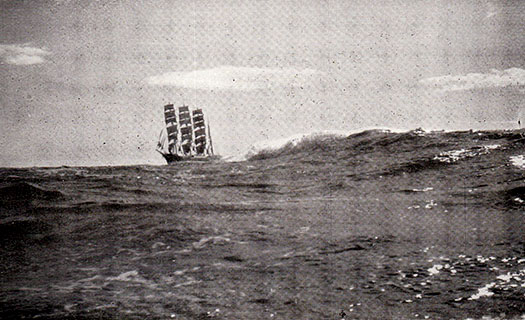
.....yet for many old salts, the true image is the lone ship at sea, going about her business. This photo of a four-masted barque was taken from a small cruising boat in the 1930s
But an ideas-laden shooting of the breeze with O'Hagan soon shows that we're going to have to learn to think a long way out of the box before we begin to meet the demanding expectations of this man and his board of trustees and directors, and the much-anticipated presence of the Tall Ships in Belfast is only a trigger to help activate a much more complex vision. Neil O'Hagan hopes not only to be instrumental in the creation of a new Irish sailing ship, but he also hopes to change the way in which we perceive such a vessel, and our expectations of the way she will be used.
In our initial blog on this back on January 17th, we thought we were making a tellingly adverse point in suggesting that the barquentine Spirit of New Zealand - which the AYT reckons will provide the best model for the development of their project – is not so much a sail training tall ship as we know it, but rather, with her large complement of 40 "trainees", she's more of a floating schoolship which happens to set sails.
Far from being blown out of the water by this "damning" criticism which I and others had voiced, O'Hagan was delighted that we'd lit upon this aspect of the plan. "Old-fashioned sail training has had its day" he says. "When education authorities and social service bodies and welfare funds and philanthropic organisations are looking for some way to provide interesting, satisfying and ultimately long-term-beneficial experiences for young people of all backgrounds and varying states of mental health including the very happily normal, they expect a much broader curriculum than is provided by the traditional sail training model".
"And come to that, so do the young people themselves. If sailing is genuinely their great leisure interest, they'll be into it already at a personal level among like-minded friends. But if they're more typical young people of today, they'll have a wide range of interests, and during the ten day cruises which we hope to make the backbone of the new ship's programme, the sailing will only be part of it."
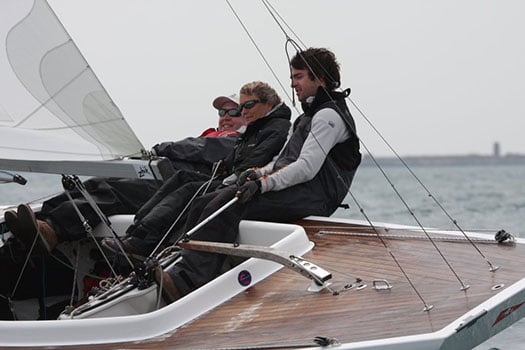
Away from the day job - Neil O'Hagan helming a Dragon
Its not that O'Hagan is anti-sailing. Far from it – he has been seen in the thick of things in the midst of the International Dragon Class in recent years. But a good liberal education with time in the Smurfit Business School in UCD and extensive family links all along Ireland's eastern seaboard north and south, plus direct business experience in both Dublin and Belfast, give him a breadth of vision to provide the AYT with a real sense of purpose.
The Atlantic Youth Trust has been quietly building itself since it emerged from a representative workshop researching the building of a sailing ship for Ireland, held in Dublin Port in the Spring of 2011. From that, a Steering Group of Lord Glentoran and Dr Gerald O'Hare from the north, and Enda O'Coineen and David Beattie from the south – all of whom had worked together before on other north-south youth sailing projects – was set up, and they commissioned a professional consultancy group – CHL Consulting of Dun Laoghaire – to work with them in producing a Vision & Business Plan, which eventually ran to 96 detailed pages.
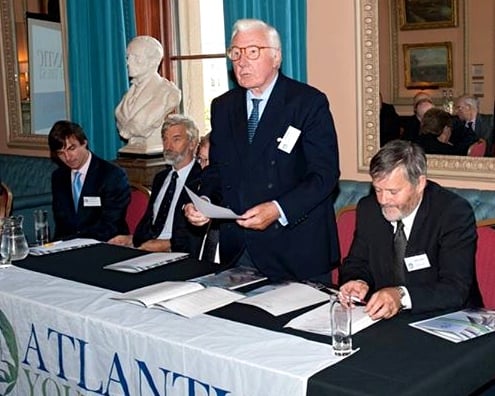
The Chairman Lord Glentoran (Gold Medallist at the 1965 Winter Olympics) at the AGM of the Atlantic Youth Trust with Executive Director Neil O'Hagan (left), Sean Lemass and Director Enda O'Coineen (right)
In due course, the Atlantic Youth Trust emerged with Olympic Gold Medal veteran Lord Glentoran as Chairman. And with Neil O'Hagan as Executive Director, the show was on the road with the detailed worldwide investigation of 25 successful educational schemes involving sailing ships - note we've dropped that "sail training" tag already. And in New Zealand they found something that was really new, something that fell in with their view that the double loss of the Asgard II and the Lord Rank provided an opportunity for a truly fresh look what a national sailing ship might be and do.
It's an extraordinary place, New Zealand - particularly from a maritime point of view. Far from seeing their isolation as a drawback, they use it as an advantage for fresh thinking. And they don't cling to time-hallowed ways brought over from "the old country". On the contrary, being in a new country is seen almost as an imperative for trying new ways and ideas, hence they're at the sharp end of top events like the America's Cup.
And as they were far from the fleets of established tall ships in Europe and America, with the Spirit of New Zealand they had to develop new ways of using a vessel which would spend much of her time cruising their own extensive and very varied coastline on her own, distant from the Tall Ship sailfests which are such a feature of the programme in the more compact and crowded parts of the world.

Spirit of New Zealand is barquentine-rigged
Thus by geographic necessity. New Zealand is ahead of the curve in developing ways of contemporary validity in the use of large sailing ships. We all hear of what a marvellous party the Tall Ships will activate in Belfast, just as they've done before in Dublin, Cork and Waterford. But hold hard just a moment. Isn't sail training aimed at young people mostly between the ages of 15 and 25? Surely their central involvement in vast open air quayside parties - with the inevitable underage alcohol intake possibilities – is totally at variance with the healthy idealism of the concept?
For sure, the organisers of modern Tall Ships Festivals go to enormous effort to ensure that they're genuinely family-friendly events. But the ancient traditions of sailors in port can be difficult to escape. So when you've a proposed programme which is essentially based on recruitment through continuing contact with secondary schools and similar age cohorts – as is the case with the Atlantic Youth Trust project – then it becomes increasingly desirable to have a ship which is large enough to be self-sufficient, with a viable way of onboard life built around large shared areas, such that the traditional waterfront-oriented harbour visits will no longer be such an important part of the cruise programme.

Splendid isolation. Spirit of New Zealand in an anchorage remote even by New Zealand standards
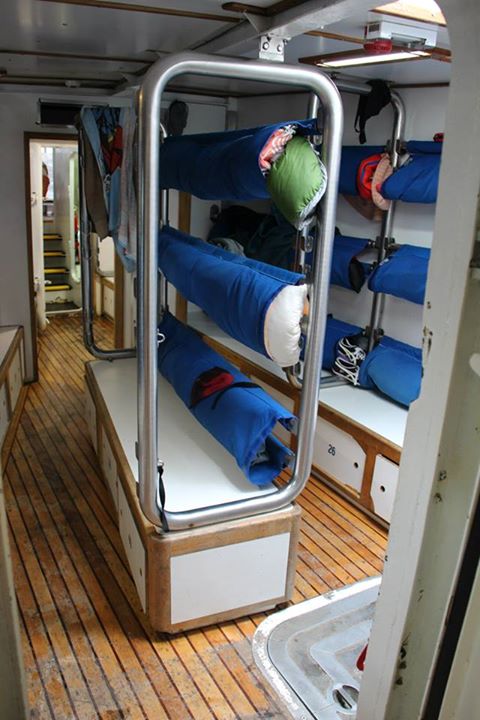
Packing them in....as she carries a crew of 40 trainees, and with space required for extensive communal areas, Spirit of New Zealand's bunks are efficiently planned
Of course the new vessel will take part in Tall Ships Races and Tall Ships Festivals, and of course she'll make the occasional ambassadorial visit, both along the Irish coast and abroad. But with the underlying philosophy of the ship being largely self-sufficient of shoreside distractions other than when they're environmentalist and educational ventures, sometimes with an expeditionary element, then the more gregarious aspects of her yearly routine will be kept well in perspective, and everyone will be the better for it.
As it's essentially a cross-border venture, equal funding from the two governments – each of which it is hoped will put up 30% of the capital expenditure - is anticipated, and with a fresh tranche of Peace Process money on the horizon, the resources are gradually building as people get used to the idea. There has also been much technical background research, and leading naval architects Dykstra of The Netherlands are on the case with an impressive scenario, for as Trustee and Director David Beattie has put it, this one isn't going to be cobbled together, it's going to be a "best in class project".
As the planned use of the vessel is essentially civilian, she will be Ireland's sailing ship without being the national sailing ship. There's more than a slight difference to the Asgard situation. In many other countries, the most impressive tall ships are part of the naval service, but in Ireland we have a Naval Service sailing vessel already, she is the ketch Creidne which was the national sail training vessel between the decommissioning of the first Asgard in 1974 and the commissioning of Asgard II in 1981. In recent years, she has had a major refit and is now actively sailed, but as Ireland's Naval Service is so essentially Cork-based, the Creidne is very much part of the scene in Cork Harbour and the Naval Base at Haulbowline.
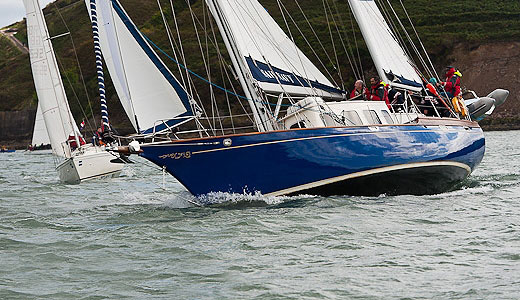
The Naval Service have Creidne for sail training purposes for their own personnel. Photo: Bob Bateman
In fact, although the Atlantic Youth Trust does have a Cork element to it, and advisers include several leading figures in the Cork marine industry, the reality is that it is first and foremost a cross-border enterprise between offices in Dublin and Belfast.
This means that Cork – which is the true capital of maritime development in Ireland, and I mean that in all seriousness – is an associate port to the Atlantic Youth Trust project, rather than a central pillar of it. But I don't think the people of Cork would wish to have it any other way. When I was in the southern capital for the fund-raiser for the new National 18 class development a month or so ago, Class President Dom Long kicked off proceedings by explaining how it was the Corkonian sense of independence which had inspired the mighty leap in National 18 design. He did this by showing a map which neatly illustrated the Cork sailor's view of Ireland.

The Cork sailor's view of Ireland
It says everything. But I don't think the Atlantic Youth Trust should lose any sleep over the fact that they might be seen as being on a Dublin-Belfast axis from which Cork is as usual going its own sweet way. 'Twas ever thus. And anyway, in the end the Corkmen will probably provide many of the officers for the proposed new vessel to which we wish, on this fine Easter Saturday morning, the very fairest of fair winds.
Drogheda Port Launches Sail Training Bursary Scheme 2015
#sailtraining – The Drogheda Sail Training Bursary Scheme for 2015 in conjunction with the Irish Maritime Festival has been announced. On Tuesday last (18th November) the Drogheda Port Company and Sail Training Ireland hosted an information evening for school principals and local leaders in the education and youth work sectors on the scheme.
The main objective of the evening was to bring the scheme to the attention of the various schools and groups and to encourage them to nominate trainees for the programme for 2015 and beyond.
The scheme was established in 2013 by Drogheda Port Company and Sail Training Ireland in conjunction with the inaugural Maritime Festival and it is kindly sponsored by a number of local and international businesses. It is designed to potentially change lives by providing access to sea-going voyages for young people from all backgrounds aged between 16-17yrs.
Although Sail Training involves participants undertaking voyages on tall ships as part of the working crew; it is not all about sailing. The purpose is to allow them the opportunity to develop as individuals and gain a real sense of confidence, resilience, adventure, and in most cases this will have a profound effect on their lives. The unique training programme on board the ship is carefully designed by Sail Training Ireland, the national sail training organisation. There is a lot of passion and effort put into ensuring the selected trainees have an experience they will take with them through life.
This quote was taken from Carolanna Foley, a trainee on the inward voyage in June 2014. 'Now we stand here, not only as shipmates but as friends, capable of tying at least three important knots with our eyes closed, navigating by point, wind and compass, and enlightened by the knowledge that the only rope on a ship called a rope is in fact the bell rope!'
Speakers on the night included Michael Byrne, manager of Sail Training Ireland and Jonathan O'Brien, programme co-ordinator, Spirit of Oysterhaven.
The voyages next year will take place during the Irish maritime Festival in June and will again be on board the only Irish sail training vessel Spirit of Oysterhaven. Information packs are available in local secondary schools and youth group organisations.
Sail Training Ireland is also currently seeking leaders with experience in residential youth work or similar. If this opportunity interests you or indeed you would like to be involved as a sponsor of the scheme.
New Site Helps Finding Boating Courses Plain Sailing
#SAIL TRAINING - A new website designed to help make it easier and quicker to find boating training courses across the UK, US, Europe and worldwide has just been launched.
The Boating Hub is aimed at both beginners and more experienced boating enthusiasts, and covers a wide range of RYA, ASA and Yachting Australia accredited and alternative non-accredited courses for power, motor and sail.
The new site streamlines the often time-consuming and frustrating process of looking for boating courses, bringing together for the first time all relevant opportunities for beginners and advanced enthusiasts alike in one simple place. The site has been designed to make it almost effortless for anyone to find the information they want in just a couple of mouse clicks.
Simply choose the type of course you’re interested in, and then choose the country or region you would like to train in, and you will be immediately presented with a comprehensive list of all relevant training centres and courses, including the course dates, a description of what the course includes, and details of any experience required. Full details of the course can be obtained by contacting the boating training centre directly through The Boating Hub.
Never again will you miss out on exciting and relevant training courses simply because you weren't previously aware of a particular training centre or course type.
Additionally, by going through the website both training centres and boating enthusiasts looking to develop their skills can find each other more easily than ever before.
Whether you're just starting out in boating for the first time, looking at extending your knowledge and experience, or aiming to gain a formal, recognised qualification in a specialised field, The Boating Hub could be the perfect way to launch your journey.
For more visit The Boating Hub at www.TheBoatingHub.com.


